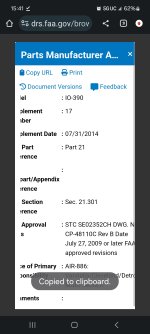Again from my neighbor - “I’m having a lot of trouble accepting “dimensionally identical” as a justification for PMA. So if a Rapco PMA’d brake disc and/or pad was dimensionally identical, but didn’t have the same brake energy or torque capability of the Cleveland part they were replacing and caused braking distance to double, that would be acceptable? It’s kind of the same logic being applied here - the Challenger filter fits, but it doesn’t filter as well as the Champion it claims to replace and it ”does no harm”. If this is how PMA works, it certainly makes me question the whole process."





